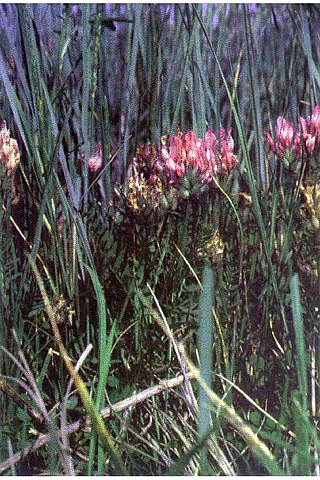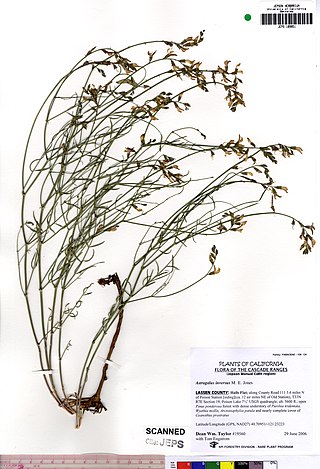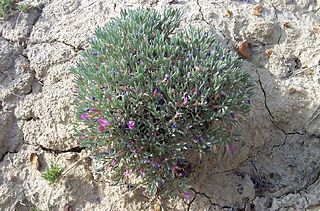Grand Junction may refer to:

Astragalus is a large genus of over 3,000 species of herbs and small shrubs, belonging to the legume family Fabaceae and the subfamily Faboideae. It is the largest genus of plants in terms of described species. The genus is native to temperate regions of the Northern Hemisphere. Common names include milkvetch, locoweed and goat's-thorn. Some pale-flowered vetches are similar in appearance, but they are more vine-like than Astragalus.

Astragalus alpinus is a species of flowering plant in the legume family known by the common name alpine milkvetch. It has a circumpolar distribution, occurring throughout the upper latitudes of the Northern Hemisphere.

Astragalus canadensis is a common and widespread member of the milkvetch genus in the legume family, known commonly as Canadian milkvetch. The plant is found throughout Canada and the United States in many habitats including wetlands, woodlands, and prairies.

Lathyrus palustris is a species of wild pea known by the common name marsh pea. It is native to Europe, Asia, and North America. It is a perennial herb with leaves made up of oval-shaped or oblong leaflets a few centimeters long. It has branched, coiled tendrils. The plant bears an inflorescence of two to eight pinkish purple pea flowers each up to two centimeters wide. The fruit is a dehiscent legume pod.

Astragalus agrestis is a species of milkvetch known by the common names purple milkvetch, purple loco, and field milkvetch. It is native to much of western and northern North America from most of Canada to the southwestern United States, as well as eastern Asia. It grows in vernally moist areas such as meadows, and is often found in sagebrush.

Astragalus deanei is a rare species of milkvetch known by the common name Dean's milkvetch, or Deane's milkvetch. It is endemic to southern San Diego County, California, where it grows on the slopes of the Peninsular Ranges between El Cajon and Tecate.

Astragalus inversus is a species of milkvetch known by the common name Susanville milkvetch.

Astragalus kentrophyta is a species of milkvetch known by the common name spiny milkvetch. It is native to western North America from central to west Canada, to California, to New Mexico. It grows in rocky mountainous areas, such as the Sierra Nevada, and on plateaus.

Lathyrus linifolius is a species of pea, commonly called bitter vetch or heath pea. The name bitter vetch is also sometimes used for Vicia ervilia and also for Vicia orobus. The tubers of Lathyrus linifolius were formerly used as an appetite suppressant in medieval Scotland, and this use has brought the plant to recent medical attention. Attempts are being made to cultivate the plant on a commercial scale.

Astragalus limnocharis var. montii, synonym Astragalus montii, is a rare variety of flowering plant in the legume family. It is known by the common name Monti's milkvetch. It is endemic to Utah in the United States, where there are only three known populations. Under the synonym A. montii, it is a federally listed threatened species of the United States.

Astragalus iselyi is a rare species of flowering plant in the legume family known by the common name Isely's milkvetch. It is endemic to Utah in the United States.

Astragalus barrii is a species of flowering plant in the legume family known by the common name Barr's milkvetch. It is native to the United States, where it is a "regional endemic", occurring in parts of southwestern South Dakota, northeastern Wyoming, southeastern Montana, and Nebraska.

Astragalus schmolliae is a species of flowering plant in the legume family known by the common name Schmoll's milkvetch. It is endemic to Colorado in the United States, where it is limited to Montezuma County. It grows only on Chapin Mesa in Mesa Verde National Park.
Astragalus tyghensis is a species of flowering plant in the legume family known by the common name Tygh Valley milkvetch. It is endemic to Oregon in the United States, where it is known only from the Tygh Valley of Wasco County.
Astragalus leptaleus is a species of flowering plant in the legume family known by the common name park milkvetch. It is native to the Rocky Mountains of the United States, where it occurs in Idaho, Montana, Wyoming, and Colorado.

Astragalus molybdenus is a species of flowering plant in the legume family known by the common names Leadville milkvetch and molybdenum milkvetch. It is endemic to Colorado in the United States. If the separate species Astragalus shultziorum and Astragalus lackschewitzii are included in A. molybdenum the range expands into Wyoming and Montana.
Astragalus wetherillii is a species of flowering plant in the legume family known by the common name Wetherill's milkvetch. It is native to Colorado and Utah in the United States.

Astragalus drummondii is a species of flowering plant in the legume family known by the common name Drummond's milkvetch. The botanist Thomas Drummond first identified the plant during his travels in North America from 1825 to 1835, the year of his death. Astragalus drummondii is one of many plants named after him. Upon the return of samples collected by Drummond to England, his findings were published in Sir William Hooker’s Flora Boreali-Americana in 1840.

Astragalus crassicarpus, known as ground plum or buffalo plum, is a perennial species of flowering plant in the legume family, Fabaceae, native to North America. It was described in 1813. The fruit is edible and was used by Native Americans as food and horse medicine. It is a host of afranius duskywing larvae. It is also known as groundplum milkvetch and pomme de prairie.
















